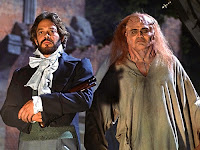Although it has Roger Corman as director, producer and co-writer (and even gives him a possessory credit), Frankenstein Unbound boasts a higher-caliber cast and higher production values than one might expect from a Corman production. Unbound marks both Corman's return to directing after a nearly 20-year hiatus and the last film to date that he's directed (he's now 90 years old but still producing regularly, so one more turn as a director isn't entirely out of the question), and he was lured back mainly by the amount of money he was offered. Certainly a lot of the budget went into paying Corman, but it also went toward the solid cast and lovely locations. The movie only starts looking like a typical Corman B-movie during the baffling finale, with its bargain-basement set design full of light-up doodads that look like they were purchased from Spencer Gifts.
Before that, though, the movie starts in a future (the year 2031) that looks futuristic enough, with John Hurt as Joseph Buchanan, a scientist who, much like Victor Frankenstein, has ignored the unintended consequences of his latest invention. He's created an ultra-powerful weapon, but its side effects include rips in the time-space continuum (oops), and soon Buchanan gets zapped from the New Los Angeles of the future to Geneva, Switzerland, in 1817. There he meets both Victor Frankenstein (Raul Julia) and Mary Shelley (Bridget Fonda), who coexist in this movie's version of the past. Seemingly not all that concerned with the way he's potentially destroyed time and space, Buchanan sets about meddling in the Frankenstein story.
Based loosely on a novel by Brian Aldiss, Unbound actually sticks fairly closely to the details of Shelley's novel when they intersect with its plot. The monster (Nick Brimble) is articulate and thoughtful, as opposed to the simple-minded brute of most film adaptations. Buchanan's mission even hinges on his desire to protect Justine Moritz, accused of murdering Victor Frankenstein's brother William, a murder that was actually committed by Frankenstein's monster. This is a fairly obscure detail from Shelley's novel to make into a central plot point, but it does give Buchanan a strong motivation for both stopping Frankenstein from creating another monster (the mate that the first monster has demanded) and for seeking out the help of Mary Shelley. Disappointingly, Mary ends up serving virtually no purpose in the story, other than to have sex with Buchanan in a rather icky turn that is apparently taken directly from Aldiss' novel. She disappears from the plot almost immediately after that, leaving Jason Patric and INXS' Michael Hutchence with minimal screen time as Lord Byron and Percy Shelley, respectively.
Buchanan is able to impress Mary because he has a talking car that came with him from the future, and his eventual plan to both destroy Frankenstein and return to his own time has more than a few echoes of Back to the Future. But its ultimate result leads to the very confusing final act, which takes place in some sort of post-apocalyptic landscape and pretty much ignores the idea of Buchanan ever returning home. The set design also starts looking cheaper and cheaper, and the more the movie focuses on the goofy-looking monster (who resembles a lesser Star Trek alien), the harder it is to take seriously. Julia gives Frankenstein the proper mix of arrogance and scientific obsession, but once he's gone, the movie loses its way. It turns into just another silly Corman production.




No comments:
Post a Comment